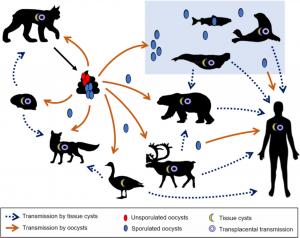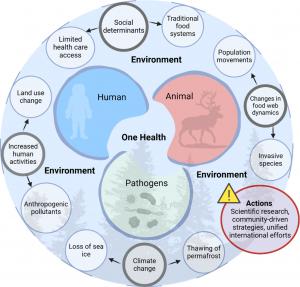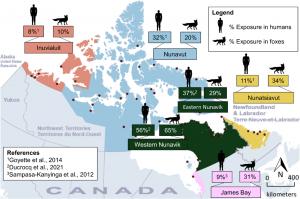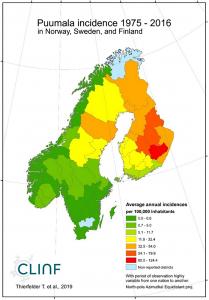
Scientists blame climate change for spread of infectious diseases and unleashing of ice-locked microbes in Arctic

Potential routes of transmission of the zoonotic parasite Toxoplasma gondii in the North, with focus on free-ranging wildlife hosts and the shared environment. (Reprinted and modified with permission from Springer Nature: Springer, Toxoplasmosis in North

The One Health concept of the Arctic showing how the large number of environmental stressors driving zoonotic infectious diseases, and where the cycle can be broken through evidence based collective action. Credit: Science of the Total Environment (2024).
Climate change in the Arctic is paving the way for the spread of infectious diseases with pandemic potential, warn scientists.
SHARJAH, EMIRATE OF SHARJAH, UNITED ARAB EMIRATES, April 8, 2025 /EINPresswire.com/ -- by University of Sharjah
Climate change is creating new pathways for the spread of infectious diseases like brucellosis, tularemia, or E. coli in the Arctic, according to a broad international consortium of scientists with a wide range of expertise in human, animal, and environmental health in the North Pole.
The scientists have published their findings in the journal Science of the Total Environment in which they demonstrate how the melting ice is opening new areas for travel or industry with people coming into closer contact with the once pristine Arctic. (DOI: https://doi.org/10.1016/j.scitotenv.2024.176869)
They warn that the thawing of soil frozen for thousands of years in the Arctic could unlock dormant microbes housed in bodies of dead animals and other creatures, raising the risk of diseases with pandemic potential.
The authors recommend measures “to enhance awareness and management of existing and emerging zoonoses with epidemic and pandemic potential while also focusing on the impacts of various environmental stressors and lifestyle factors on zoonoses in the Arctic.”
As the ice in the Arctic melts, more industries and people are flocking to the area, raising the chance for infectious diseases to spread, says Dr. Khaled Megahed Abass of the University of Sharjah and a co-author, stressing that “permafrost thawing could even release ancient bacteria or viruses that have been frozen for thousands of years.”
In their extensive review, the authors analyze scientific studies about and government documents from the Arctic, with a particular focus on Canada, Alaska, Greenland, and Northern Europe.
“The aim of this investigation was to understand what lessons we can learn the past to help Arctic communities better prepare for future health risks,” adds Dr. Abbas. “Climate change and pollution are affecting both animal and human health — our research looked into how these two forces are interconnected. As the Arctic warms faster than most other parts of the world, we’re seeing changes in the environment—like melting permafrost and shifting ecosystems—that could help spread infectious diseases between animals and people.”
In scientific jargon, these diseases are called zoonotic pathogens with the ability to jump from wildlife to humans, especially when human activities and animal habitats overlap in a manner upsetting environmental balance. The pathogens may be parasitic, viral, or bacterial. They can include unconventional agents with the ability to spread to humans through different means like water food or the environment.
Climate change is blamed for the erratic and long-term shifts in the Earth’s weather and temperature with scientists reporting a world that has been warming up quickly in the past decades.
The Earth’s warming is behind the permafrost thaw – a process which refers to the melting of the ice in the frosty soil of Arctic regions. A thawing permafrost can have grave consequences on the environment and the inhabitants as the frozen soil melts.
The study is an extensive review of the literature and government documents from the North Pole in which a broad international consortium of scientists with a wide range of expertise “describe a selection of case studies highlighting the importance of a One Health approach to zoonoses in the circumarctic, encompassing human health, animal health, and environmental health aspects,” the authors write.
The significance of the study emerges from the authors’ adoption of and reliance on the One Health approach in analyzing previous literature and government reports documenting transformations taking place in the Arctic due to climate change.
In their extensive review, they attempt to sustainably balance and optimize the health of ecosystems in the Arctic, recognizing that health issues, whether related to people, animals, plants, or the environment, are closely linked and interdependent.
The study, according to Abass, shows that “local communities and researchers have already noticed signs of these changes, and some are adapting—but many risks are still poorly understood.”
Dr. Abass warns that what is happening “in the Arctic doesn’t stay in the Arctic. The environmental stressors we studied have ripple effects that reach far beyond the polar regions.
“Climate change is not only melting ice—it’s melting the barriers between ecosystems, animals, and people. This study shows how environmental disruption can directly impact human health.”
The authors reaffirm the need to “enhance awareness and manage Arctic zoonoses with pandemic potential,” underscoring the fact that “about three-quarters of all known human infectious diseases are zoonotic including Arctic ones” at a time “pollution, climate change and biodiversity loss aggravate zoonoses transmission in the Arctic”.
They write, “The cases highlight critical gaps in monitoring and current knowledge, focusing on environmental stressors and lifestyle factors, and they are examples of current occurrences in the Arctic that inform on critically needed actions to prepare us for the future.”
Dr. Abass says he and colleagues authoring the study are upbeat about the interest their project has already generated. “This research has attracted interest from outside academia. Public health organizations, environmental agencies, and even northern industries (like mining and shipping) are starting to recognize the need to monitor health risks linked to changing Arctic conditions. This includes policymakers concerned about pandemic prevention and food safety in remote areas.”
The authors see their comprehensive review as a warning for “governments and communities to take action early—before outbreaks occur. It supports the development of better disease surveillance, more robust environmental monitoring, and climate-resilient public health systems. The study also shows the importance of indigenous knowledge in detecting early signs of ecosystem and health changes.”
The study highlights the importance of international cooperation coupled with transdisciplinary research collaboration. The fact that the findings stem from an international consortium involving over 15 institutions across Europe and Canada, notes Dr. Abass, is a sign “of the significance of multidirectional knowledge exchange, thematic networks and internationalization in addressing climate change issues in the Arctic”.
LEON BARKHO
University Of Sharjah
+971 50 165 4376
email us here
Distribution channels: Environment, Natural Disasters, Science, Waste Management, World & Regional
Legal Disclaimer:
EIN Presswire provides this news content "as is" without warranty of any kind. We do not accept any responsibility or liability for the accuracy, content, images, videos, licenses, completeness, legality, or reliability of the information contained in this article. If you have any complaints or copyright issues related to this article, kindly contact the author above.
Submit your press release

